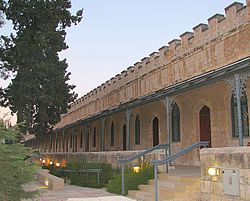- Expansion of Jerusalem in the 19th-century
-
The Departure from the walls in Jerusalem was the process of building new residences outside of the Old City walls, and shifting the city center to the new neighborhoods. The process started in the mid-19th century and by the early 20th century had entirely transformed the city.
In the mid 19th century, with an area of only one square kilometer, the Old City had become overcrowded and unsanitary, and rental prices were increasingly rising.[1]
In the 1850s, institutions including the Russian Compound, the Bishop Gobat School, and the Schneller Orphanage marked the beginning of permanent settlement outside the Jerusalem Old City walls.[1] In 1855, Johann Ludwig Schneller, a Lutheran missionary who came to Jerusalem at the age of 34, bought a plot of land outside the Old City walls when the area was a complete wilderness. He built a house there but was forced to move his family back inside the walls after several attacks by marauders. When the Turks erected outposts along Jaffa Road, between Jerusalem and the port city of Jaffa, and armed guards on horseback patrolled the road, the family returned.[2]
The public institutions were followed by the development of two philanthropically supported Jewish neigborhoods, Mishkenot Sha’ananim and Mahane Israel.[1]
Mishkenot Sha’ananim (Hebrew: משכנות שאננים) was the first Jewish neighborhood built outside the walls of the Old City of Jerusalem, on a hill directly across from Mount Zion.[3] It was built by Sir Moses Montefiore in 1860 as an almshouse, paid for by the estate of a wealthy Jew from New Orleans, Judah Touro.[4] Since it was outside the walls and open to Bedouin raids, pillage and general banditry rampant in the region at the time, the Jews were reluctant to move in, even though the housing was luxurious compared to the derelict and overcrowded houses in the Old City.[5] As an incentive, people were paid to live there, and a gate was built around the compound with a heavy door that was locked at night.[6] The name of the neighborhood was taken from Book of Isaiah 32:18: "My people will abide in peaceful habitation, in secure dwellings and in quiet resting places."[4]
Mahane Israel (Hebrew: מחנה ישראל), built in 1869, was the second Jewish neighborhood built outside the walls of the Old City.[7] Mahane Israel was a "communal neighborhood" and was built by and for Maghreb (western North Africa) Jews.
Nahalat Shiv'a was the third residential neighborhood built outside the city walls. It was founded in 1869 as a cooperative effort by seven Jerusalem families who pooled their funds to purchase the land and build homes. Lots were cast and Yosef Rivlin won the right to build the first house in the neighborhood.[8]
The neighborhoods that make up the Nachlaot district were established outside the walls in the late 1870s. The first was Mishkenot Yisrael, built in 1875. The name comes from a biblical verse (Numbers 24:5): "How goodly are thy tents, O Jacob/Thy dwellings, O Israel." Mazkeret Moshe was founded by Sir Moses Montefiore in 1882 as an Ashkenazi neighborhood. Ohel Moshe is a Sephardi neighborhood established alongside it.[9]
In 1879, Nissan Beck founded the Jewish neighborhood Ḳiryah Ne'emanah, better known as Batei Nissan Bak.[10] Beck bought the land and paid for the construction of the neighborhood, opposite the Damascus Gate of the Old City. The neighborhood was originally built for ultra-Orthodox Ashkenazi Jews, but since few members of his community wanted to live there, the neighborhood was eventually divided into three different complexes, one for Georgian Jews, one for Caucasus Jews and the third for Jews from Syria and Iraq.[11]
Nahalat Shimon was founded in 1891 by Sephardic and Ashkenazi Jewish Kollels, to house poor Yemenite and Sephardi Jews. The land was purchased in 1890 and the first homes were built soon after, housing 20 impoverished families. [12]The cornerstone of the neighborhood was laid in 1890, near the Tomb of Simeon the Just.[13][14]
References
- ^ a b c Sephardi entrepreneurs in Jerusalem: the Valero family 1800-1948 By Joseph B. Glass, Ruth Kark. p.174
- ^ A Guide to Buildings in Jerusalem
- ^ Mishkenot Sha'ananim, jewishvirtuallibrary.org
- ^ a b Street People, Helga Dudman, Jerusalem Post/Carta, 1982, pp. 21-22
- ^ Jerusalem architectural history
- ^ http://www.jafi.org.il/education/noar/sites/yeminmosh.htm More information about Yemin Moshe
- ^ http://www.biu.ac.il/js/rennert/history_11.html
- ^ Beginnings of the New City
- ^ Jerusalem: Architecture in the late Ottoman Period
- ^ The streets of Jerusalem: who, what, why By Ronald L. Eisenberg. p. 39
- ^ [1]
- ^ 13 new Jewish homes in Jerusalem near Shimon Hatzadik
- ^ Mathilde A. Tagger, Yitzchak Kerem. Guidebook for Sephardic and Oriental genealogical sources in Israel. p. 44
- ^ Sephardi entrepreneurs in Jerusalem: the Valero family 1800-1948 By Joseph B. Glass, Ruth Kark. p.254
Categories:- History stubs
- History of Jerusalem
- Urban planning in Palestine
- Jews and Judaism in Palestine
Wikimedia Foundation. 2010.



